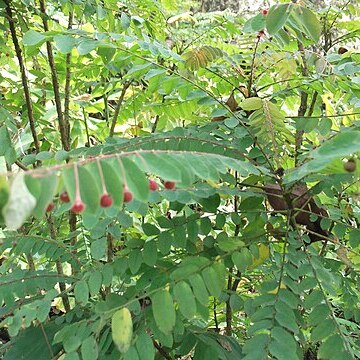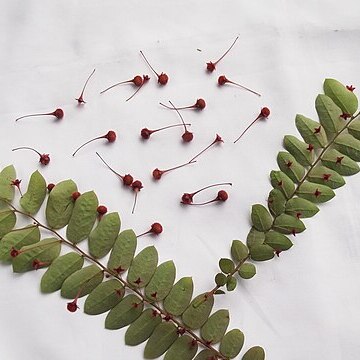Dioecious several-stemmed glabrous shrub with ascending branches, 1–3 m. tall.. Bark smooth, grey.. Twigs pinkish grey.. Orthotropic shoots robust, angular. Leafy plagiotropic shoots 6–10 cm. long, sometimes floriferous at the base. Brachyblasts present, which may give rise either to secondary orthotropic or plagiotropic shoots, or which may be directly floriferous, with dense fascicles of flowers borne on the older twigs.. Cataphylls narrowly lanceolate, 2 mm. long, light brown, soon falling. Cataphyllary stipules lanceolate, 2 mm. long, light brown with translucent laciniate hyaline margins.. Leaves of the plagiotropic shoots distichous; petioles 1–2 mm. long; blades elliptic-ovate, elliptic, obovate or sometimes suborbicular, (1–)1.5–2.5(–2.8) cm. long, 0.7–1.5 cm. wide, obtuse, rounded or occasionally subtruncate at apex, cuneate or rounded at base, membranaceous, midrib commonly not running to the apex, lateral nerves 5(–7) pairs, not or scarcely prominent above, slightly so below, mid-green or yellowish green above, paler beneath.. Stipules linear-lanceolate, 1 mm. long, chestnut-brown with laciniate hyaline margins.. Male flowers in dense fascicles on the older twigs, with or without attendant lateral leafy shoots; bracts broadly ovate to transversely ovate, 0.5 mm. long, chestnut-brown, fimbriate; pedicels 4–8 mm. long, capillary; sepals (5–)6, very irregular and unequal, ± obovate-suborbicular to ovate-oblong, (0.5–)1–1.5(–2) mm. long, brownish and laciniate at the apex, otherwise yellowish green; disc annular, ± entire, thin and flat; stamens (5–)6, free or ± so, 2 mm. long, anthers ovoid, slightly recurved, 0.3 mm. long, longitudinally dehiscent, with the thecae-walls folded hard back after dehiscence.. Female flowers either in dense fascicles on the older twigs, or else in the lowest axils of the lateral leafy shoots; bracts elliptic-ovate, 1 mm. long, otherwise similar to those of the ♂ flowers; pedicels (4–)7–10 mm. long, slender, extending to 3–4 cm. in fruit; sepals 6, the 3 outer ovate-lanceolate, 1 mm. long, with a brown area and laciniate at the apex, otherwise yellowish-green, the 3 inner obovate-suborbicular, 1.5 mm. long, mostly greenish and entire, but with a small brown mark and irregular margin at the apex; disc annular, shallowly crenulate, thin and flat, adnate to the bases of the sepals; ovary subsessile, subglobose, ± 1 mm. diameter, slightly reticulate-rugulose; styles 3, connate at the base, ± 1 mm. long, erect and recurved at first, later spreading, slender, bifid, the stigmas subulate-filiform, acute, slightly papillose.. Fruit pendent, rounded-trigonous, 4–5 mm. long, 8–10 mm. diameter, shallowly reticulate-venose, crustaceous, pale green.. Seeds ovoid, 3–3.5 mm. long, 2.5–3 mm. wide, faintly lineate, very pale brown or whitish, with a darker depression in the vicinity of the hilum.
More
Female flowers either in few-flowered fascicles on the older twigs or else solitary in the lowest axils of the leafy shoots; bracts ± as in the male; pedicels 0.5–1 cm long, extending to 2–4 cm long in fruit, slender; outer sepals smaller than inner, otherwise sepals ± as in the male; disk 1.5 mm in diameter, collar-like, shallowly hexagonal; ovary 1.5 mm in diameter, ± sessile, subglobose, smooth; styles 3, 2 mm long, united at the base, ± erect at first, later spreading, slender, bifid, the stigmas filiform, minutely papillose.
Male flowers fragrant, usually in dense fascicles on older leafless twigs; bracts 1 mm long, broadly ovate, erose, chestnut-brown; pedicels 3–4(7) mm long, slender; sepals 6, c. 1 × 0.5–1 mm, obovate-suborbicular, the outer convex, the inner ± flat, fimbriate, brown at the apex, otherwise yellowish; disk 1 mm in diameter, annular, ± entire, thin, flat; stamens (5)6, 2 mm long, filaments free or ± so, anthers 0.3 mm long.
Foliage leaves distichous; petioles 1.5 mm long; blades up to 4.5 × 3 cm, elliptic, obovate or ± suborbicular, obtuse to rounded at the apex, cuneate to rounded at the base, chartaceous, midrib commonly not running to the apex, bluish-green to yellowish-green above, paler beneath; lateral nerves in 5–7 pairs, not prominent above, scarcely so beneath.
Short shoots either giving rise to secondary leafy shoots and lead shoots (in female plants) or else directly floriferous (in male plants).Scale leaves and their stipules 1.5–2 × 0.5–1 mm, narrowly lanceolate, light brown with fimbriate hyaline margins.
Many-stemmed shrub, up to 3 m high. Lateral branches modified to resemble pinnate leaves. Leaves yellowish green. Male flowers densely fasciculate. Fruits 8-10 mm in diameter, on slender stalk.
Fruit 4–5 × 8–10 mm, pendent, rounded, depressed-trigonous, shallowly reticulate-venose, crustaceous, pale green ripening to yellowish.
An often spindly, unbranched, sometimes decumbent, glabrous shrub or small tree to 4.5 m high; plants dioecious.
Seeds 2.5–3 × 2–2.5 mm, ovoid, faintly lineate, pale brown to whitish, with a deep, dark, hilar excavation.
Lateral leafy shoots up to 12 cm long, sometimes with flowers at the base.
Stipules 0.5 mm long, linear-lanceolate, soon falling.
Bark smooth, mottled, light grey, flaking.
Young lead shoots robust, angular.
Twigs often pinkish-grey.


